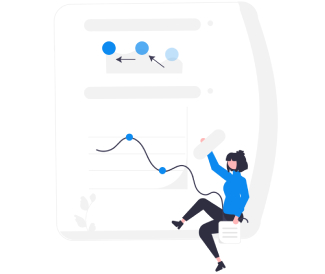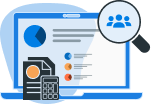Scalability Meaning
Scalability refers to an organization's ability to handle growth efficiently without compromising performance, quality, or operational stability. In simpler terms, it means your systems, processes, and infrastructure can adapt and expand without breaking down or becoming inefficient.
In HR, scalability ensures that as your company grows whether in workforce size, geographical presence, or complexity, your HR processes remain smooth and effective.
For instance, if you’re using an HRMS (Human Resource Management System) that works well for a 50-person team, it should still function seamlessly when your team grows to 500 or even 5,000 employees. If the system crashes, slows down, or fails to manage increased data, it lacks scalability.
Scalability in a Nutshell
- Efficient Growth: Ability to handle increasing workload without performance loss.
- Flexible Adaptation: Systems and processes should evolve as business needs change.
- Sustainable Expansion: No need for constant overhauls or expensive replacements.
Examples of Scalability in HR
To better understand scalability, let’s look at some real-world examples in the HR space.
1. Growing Workforce Without Chaos
A company with 50 employees may manage payroll and attendance manually or with basic software. But what happens when the company scales to 500 or even 5000 employees? An HRMS with scalability ensures payroll processing , leave tracking, and compliance management remain smooth, regardless of workforce size.
2. Handling a Surge in Job Applications
Recruitment is another area where scalability matters. Suppose a company starts with 10 job applications per month but later receives 1000 applications due to rapid growth. A scalable Applicant Tracking System (ATS) can efficiently process, filter, and track candidates without overwhelming HR teams.
3. Expanding to Multiple Locations
Companies that expand to multiple offices or even different countries need HR systems that can support diverse policies, multi-currency payroll, and compliance requirements. A scalable HRMS ensures that businesses operate smoothly across geographies.
4. Adapting to Remote and Hybrid Work Models
With the rise of remote work, businesses need HR solutions that support virtual onboarding, remote attendance tracking , and performance management across time zones. A scalable HRMS can adapt to these needs without requiring a complete system overhaul.
5. Payroll Processing at Scale
A small company might process payroll manually, but as it grows, this becomes impractical. A scalable payroll system automates salary calculations, tax deductions, and compliance checks, ensuring efficiency whether you have 10 or 10,000 employees.
6. Automated Recruitment and Onboarding
Hiring five employees a month is manageable with spreadsheets. But what if you need to hire 500? A scalable ATS can handle high-volume hiring without bottlenecks, ensuring a smooth recruitment process.
7. Performance Management
Annual performance reviews may work for a small team. However, as the company expands, real-time performance tracking and 360-degree feedback become essential. A scalable performance management system can accommodate a growing workforce without adding administrative burden.
8. Employee Self-Service Portals
As a company grows, HR teams cannot handle every single query about leaves, benefits, or policies. A scalable HRMS provides employees with self-service portals, reducing HR workload and improving efficiency.
Why is Scalability Important in HR?
Scalability isn't just about handling growth—it’s about ensuring efficiency, agility, and long-term success. Here’s why it’s crucial for HR:
1. Future-Proofing HR Operations
Businesses evolve. If your HR software can’t scale, you’ll constantly need to replace it. Scalable systems grow with your business, saving time and costs in the long run.
2. Enhancing Employee Experience
HR processes should be seamless, whether you have 10 employees or 10,000. A scalable HRMS ensures a smooth onboarding process, accurate payroll, and easy access to HR resources, keeping employees satisfied.
3. Reducing Costs and Improving Efficiency
Scalable HR systems prevent bottlenecks and inefficiencies that arise when outdated software struggles with increased workload. This means fewer manual interventions, fewer errors, and lower operational costs.
4. Ensuring Compliance and Security
As businesses grow, so do regulatory and security challenges. A scalable HRMS keeps up with evolving compliance requirements and data security measures, ensuring businesses remain legally compliant and protected.
Factors Affecting Scalability
Several factors determine whether a system, process, or business can scale effectively. Here are some key considerations:
1. Technology Infrastructure
A scalable HR system needs a strong technology backbone, such as cloud-based solutions, AI-driven automation, and robust data storage. Cloud-based HRMS platforms are inherently scalable since they allow businesses to add users, features, and integrations as needed.
2. Automation and AI Integration
Automation plays a critical role in scalability. Features like automated payroll processing , AI-driven recruitment, and chatbots for employee queries help HR teams handle larger workloads efficiently.
3. Data Management and Security
As businesses scale, they generate more HR data, employee records , payroll data, compliance reports, and more. A scalable system must handle this data securely while ensuring easy retrieval and analytics.
4. Flexibility and Customization
Every business has unique HR needs. A scalable HRMS should allow businesses to customize workflows, add new modules, and integrate with third-party applications.
5. Cost-Effectiveness
Scalability isn’t just about growth, it’s about sustainable growth. Businesses should invest in HR solutions that provide cost-effective scaling without unnecessary expenses.
Horizontal vs. Vertical Scalability in HR
When discussing scalability, it's essential to understand the two primary types—horizontal scalability and vertical scalability. Both approaches help businesses manage growth, but they function differently.
1. Horizontal Scalability (Scaling Out)
Horizontal scalability means adding more resources to handle increased demand. In HR terms, this could mean:
- Expanding cloud storage to manage growing employee records
- Integrating new software modules (e.g., adding a performance management module to an HRMS)
- Deploying additional servers to ensure smooth HR operations during peak periods
This approach is cost-effective and ensures a system remains operational even as demand grows.
2. Vertical Scalability (Scaling Up)
Vertical scalability means enhancing the existing system’s power or capacity. In HR, this could involve:
- Upgrading servers to handle increased HR data processing
- Enhancing AI-driven analytics for better decision-making
- Adding advanced automation features to streamline HR workflows
Vertical scaling is useful for performance improvements but has limitations since it relies on upgrading existing resources rather than adding new ones.
How to Ensure Scalability in Your HR System
Now that you understand scalability, here’s how to ensure your HR system grows with your business:
- Choose a Cloud-Based HRMS: Cloud solutions provide seamless scalability, allowing you to add features and users as needed.
- Invest in Automation: Automated workflows reduce manual workload and improve efficiency.
- Opt for Modular HR Software: A modular HRMS lets businesses scale by adding only the features they need.
- Prioritize Data Security: As HR data grows, ensure encryption and compliance measures are in place
- Regularly Assess System Performance: Conduct scalability testing to identify bottlenecks and areas for improvement.


 Back to Glossary
Back to Glossary